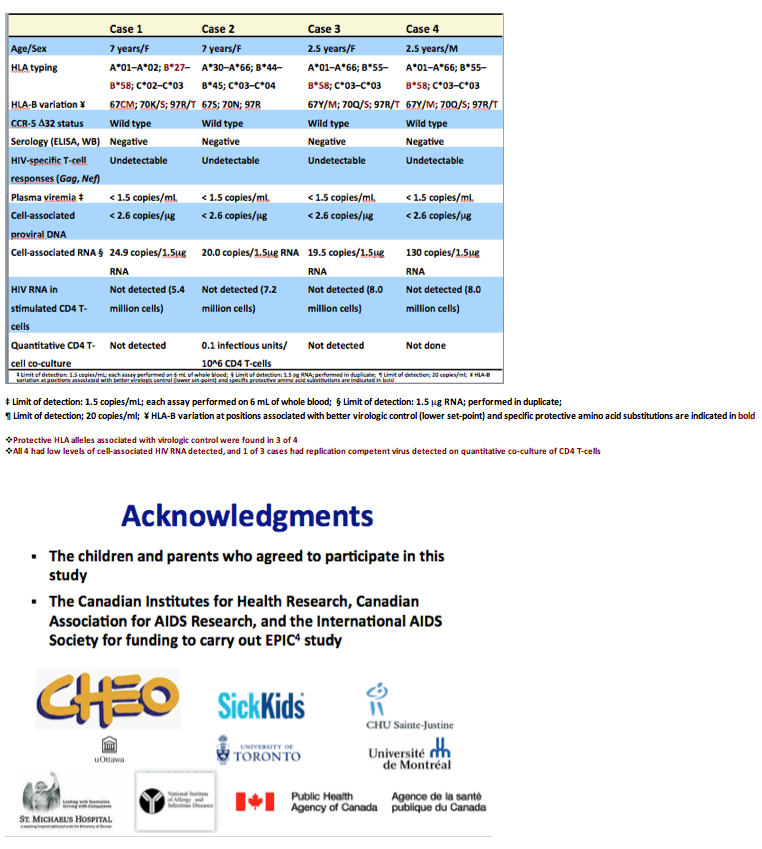 |
 |
 |
| |
cART in First Days of Life Limits Viral Reservoir Size in 4 Canadian Children
|
| |
| |
20th International AIDS Conference, July 20-25, 2014, Melbourne
Mark Mascolini
Four HIV-infected Canadian children treated with combination antiretroviral therapy (cART) within 48 hours of birth and achieving sustained virologic suppression had no detectable proviral DNA in CD4 cells and no HIV RNA in blood as measured by an ultrasensitive assay while remaining on treatment [1]. But all four had detectable cell-associated HIV RNA. These four cases double the number of reported children with undetectable HIV DNA after starting cART in the first days of life. But as the Mississippi baby case shows, undetectable HIV DNA in a cART-treated child does not guarantee viral suppression when cART stops [2].
US clinicians and researchers have reported 2 infants treated with cART in the first days of life who appeared to clear HIV from the resting CD4-cell reservoir [3]. One of these infants treated within 30 hours of birth, the Mississippi baby, had no rebound in HIV RNA for 2 years after cART stopped [3,4], but viral replication then resumed [2]. These findings suggest that rapid treatment of HIV-infected newborns may limit the size of viral reservoirs that resist treatment in chronically infected children and adults.
At some centers in Canada, newborns exposed to HIV routinely receive triple cART to prevent HIV infection. A Canadian team examined health records of 136 children who began triple cART within 72 hours of birth [1]. They determined how many children became infected with HIV despite cART and how many had a sustained virologic response to cART, defined as continued absence of detectable HIV RNA on a standard assay after reaching a viral load below 50 copies. In this subset of infants, the investigators analyzed HIV serology, HIV-specific cell-mediated responses, HLA genotyping, ultrasensitive viral load, cell-associated HIV DNA and RNA, and replication-competent HIV in peripheral blood.
All 136 newborns started zidovudine/lamivudine, 73 of them with nelfinavir, 56 with nevirapine, and 7 with lopinavir/ritonavir. Twelve of these 136 infants (8.8%) became infected with HIV despite prompt cART. Six of these 12 infants never achieved consistent viral suppression because of poor antiretroviral adherence. Two children reached an undetectable viral load and maintained it for 2 to 3 years, but poor adherence led to rebounding viremia. The remaining 4 children sustained virologic suppression for 2 to 7 years with continuing cART. These 4 children, now 3 to 7.5 years old, all continued their original regimen: zidovudine, lamivudine, and nevirapine.
All four children had a negative ELISA test for HIV antibody, all four had a plasma viral load below 1.5 copies/mL, and none had HIV-specific T-cell responses to gag or nef. Cell-associated proviral HIV DNA lay below a detection limit of 2.6 copies/ug in all four children, and HIV RNA could not be detected in 5.4, 7.2, 8.0, or 8.0 million stimulated CD4 cells. But cell-associated RNA could be measured at levels of 24.9 copies, 20.0 copies, 19.5 copies, and 130 copies per 1.5 ug RNA. Quantitative coculture was not done in 1 child, revealed no signs of virus in 2 children, and detected 0.1 infectious units per million CD4 cells in 1 child.
All children tested negative for the CCR5 delta32 deletion conferring protection against infection with CCR5-using virus. HLA alleles linked to HIV control in prior research could be detected in 3 of 4 children.
A fifth child had a rapid viral rebound after cART stopped even though the reservoir size was limited. This case, the researchers observed, "demonstrates that early cART will not be effective in all patients." Along with the Mississippi case, they noted, this child's history underlines the need for better understanding of factors contributing to reservoir size and viral control.
The researchers proposed that "absence of detectable HIV DNA and absence or low levels of replication-competent virus in peripheral blood and lack of HIV-specific immune responses" in 4 children who started cART within 72 hours of birth "suggest early cART initiation can greatly reduce HIV reservoir size." They stressed, though, that genetic factors may also have played a role in viral control among these children. The team also observed that limits on the size of blood sample collection in children could have a significant impact on accurate estimation of reservoir size.
The US National Institutes of Health planned to launch a trial of early cART for infants followed by treatment interruption in sustained responders to determine whether plasma viremia would remain undetectable without treatment [5]. Rebounding virus in the Mississippi case will require trial planners to reassess their study design. Canada has begun a prospective multicenter observational study--EPIC--to assess the impact of early versus later treatment on reservoir size and HIV control in children.
References
1. Brophy J, Chun TW, Samson L, et al. Impact of early initiation of combination antiretroviral therapy on measures of virus in peripheral blood of vertically HIV-1-infected children. AIDS 2014. 20th International AIDS Conference. July 20-25, 2014. Melbourne. Abstract TUAB0206LB.
2. National Institute of Allergy and Infectious Diseases. "Mississippi baby" now has detectable HIV, researchers find. NIH News. July 10, 2014. http://www.niaid.nih.gov/news/newsreleases/2014/Pages/MississippiBabyHIV.aspx
3. Persaud D, Deveikis A, Gay H, et al. Very early combination antiretroviral therapy in perinatal HIV infection: two case studies. CROI 2014. Conference on Retroviruses and Opportunistic Infections. March 3-6, 2014. Boston. Abstract 75LB. http://www.natap.org/2014/CROI/croi_34.htm
4. Persaud D, Gay H, Ziemniak C, et al. Absence of detectable HIV-1 viremia after treatment cessation in an infant. N Engl J Med. 2013;369:1828-1835. http://www.nejm.org/doi/full/10.1056/NEJMoa1302976
5. ClinicalTrials.gov. Very early intensive treatment of HIV-infected infants to achieve HIV remission. NCT02140255. http://clinicaltrials.gov/ct2/show/NCT02140255
----------------------------







|
| |
|
 |
 |
|
|